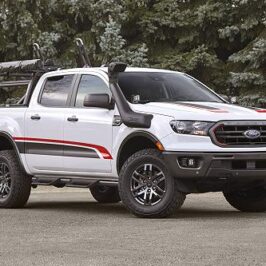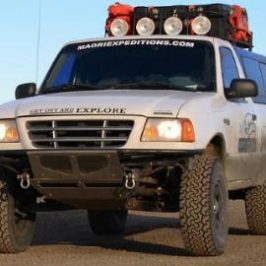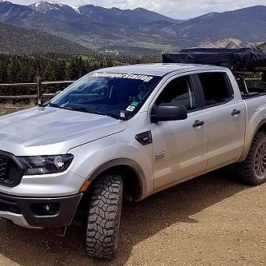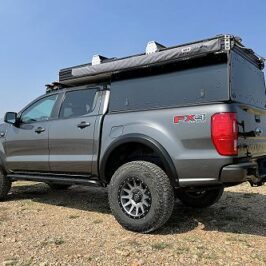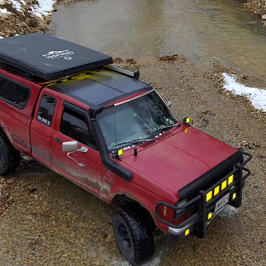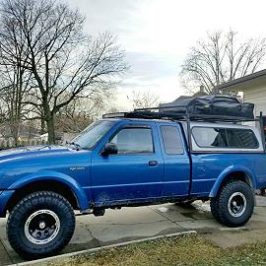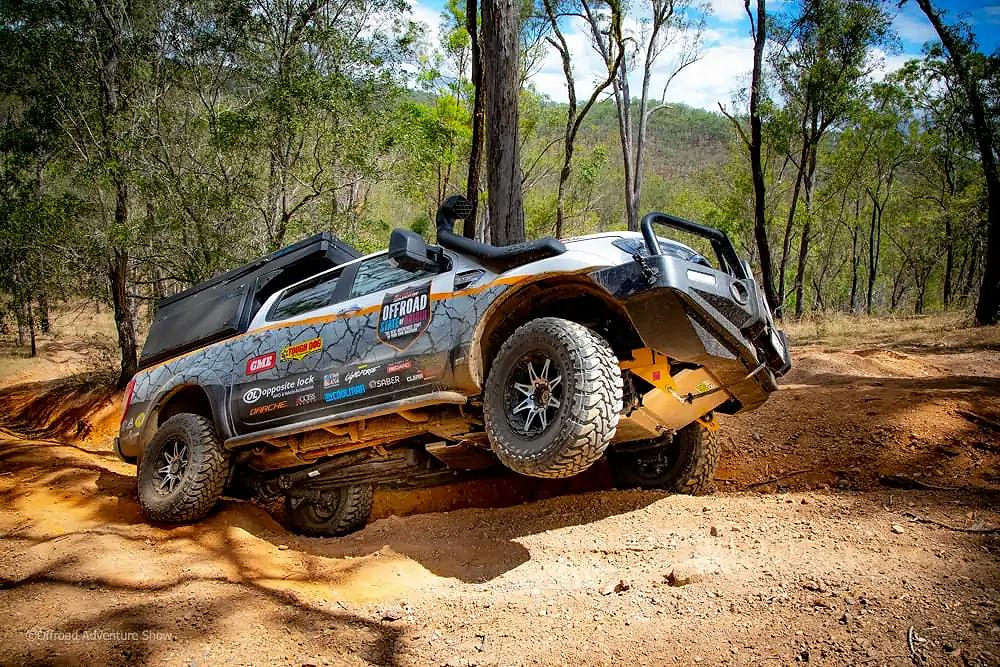
Whether you’re heading into the pines for a single night, chasing a muddy trail all weekend, or planning a multi-week overland expedition, the way you kit out your Ford Ranger (or any midsize truck) matters. Below is a complete, no-fluff guide that compares three popular approaches — Lightweight Camping Setup, Rugged Weekend Rig, and Full Overlanding Rig — and includes build sheets, gear lists, and example Ranger setups.
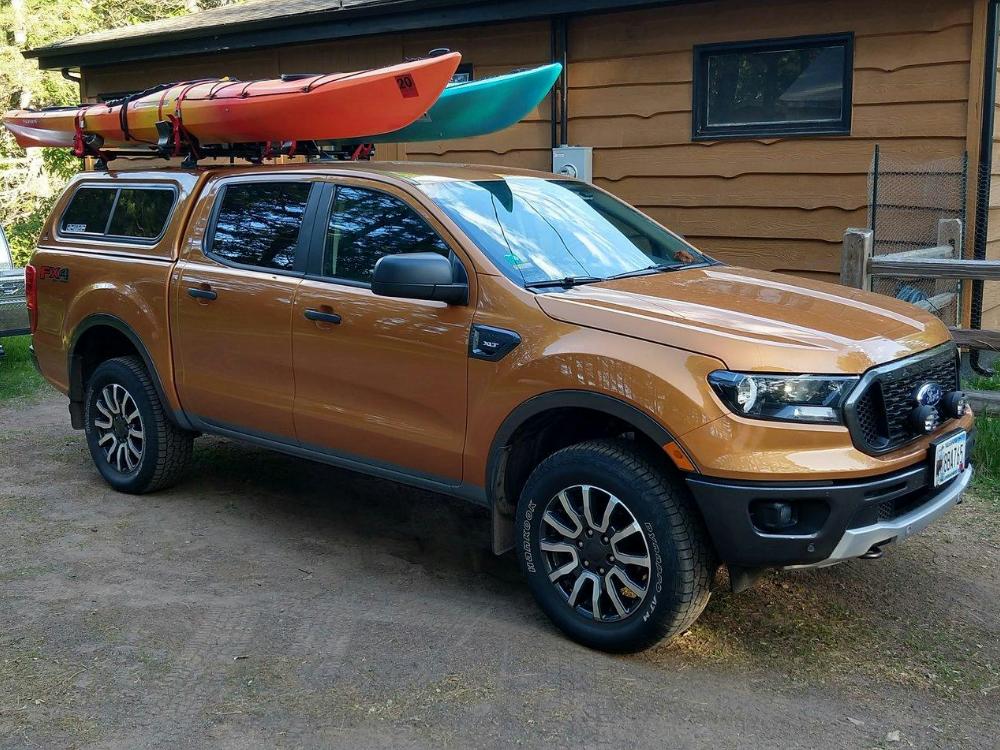
1. Lightweight Camping Setup
Definition: A lightweight camping setup is a stripped-down, efficient approach to camping in wooded or remote areas — focused on minimal gear, quick mobility, and blending in with nature — rather than hauling a big overlanding kit or towing a camper. It’s basically the cousin of a backpacking trip, but with the comfort and cargo capacity of a truck or SUV.
Core Principles
- Keep It Light — Less weight means better fuel economy, less strain on your suspension, and easier maneuverability on narrow forest trails.
- Fast Setup & Teardown — You want to be able to make camp in minutes, not hours.
- Leave No Trace — Minimize your footprint; pack out what you bring in.
Typical Lightweight Camping Gear
Shelter
- Compact ground tent or small truck-bed tent
- Hammock with a rainfly — especially good in wooded areas
- Lightweight tarp for extra rain/sun protection
Sleeping Setup
- Inflatable sleeping pad or foam mat
- Compact season-appropriate sleeping bag
- Small travel pillow
Cooking & Food
- Small single-burner stove (Jetboil or compact propane)
- Titanium or lightweight aluminum cookware
- Minimal utensils; freeze-dried meals or simple camp food
- Collapsible water container or water filter (if near streams)
Lighting
- Rechargeable headlamp
- Small LED lantern or USB string lights
Recovery & Safety
- Compact first-aid kit
- Folding saw or small hatchet for clearing branches
- Lightweight recovery strap or tow rope
- Basic tool kit
Vehicle Storage
- One or two stackable gear boxes (Pelican/Plano) for dry storage
- MOLLE panel or small cargo net for quick-grab items
- Small cooler if needed
Why It’s Ideal for Camping
- Nimble: Easier on narrow, winding forest roads.
- Quiet & Low-Impact: Smaller footprint; less disruptive to wildlife.
- Flexible: Easier to move camp if weather shifts or you find a better spot.
Example for a Ford Ranger:
A Ranger with stock suspension, all-terrain tires, a single Pelican gear box in the bed, a hammock + tarp setup, a Jetboil stove, and minimal recovery gear. Everything stows under a tonneau cover — no RTT, no heavy racks — stealthy and efficient.
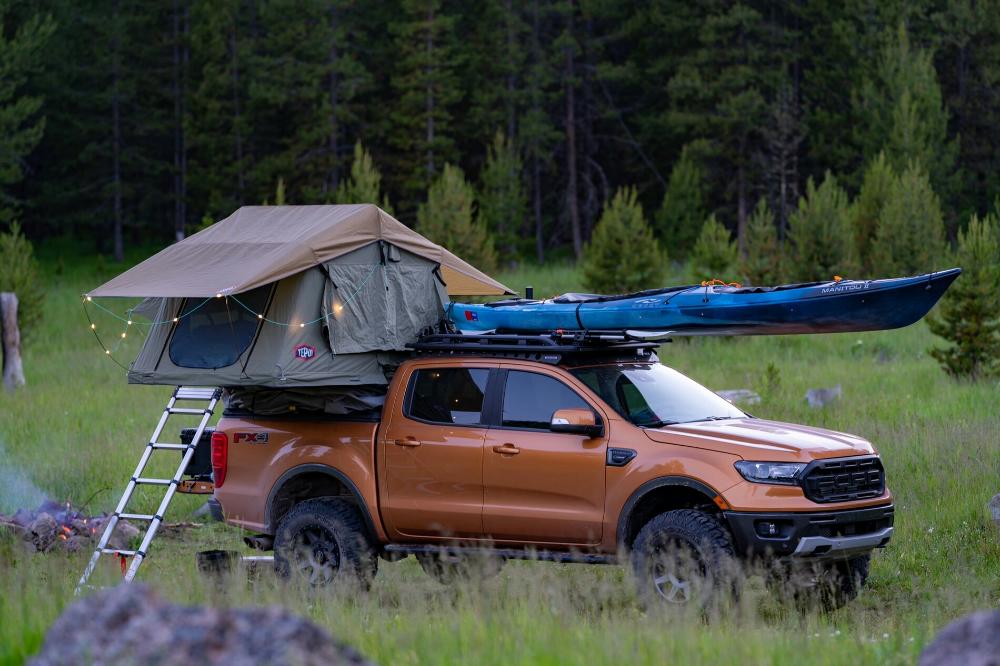
(Rugged Weekend Rig: Comfort meets capability for weekend excursions.)
2. Rugged Weekend Rig
Definition: A rugged weekend rig is a pickup, SUV, or 4×4 built (or outfitted) for short-term off-road adventures — typically 1–3 day trips — that balances durability, capability, and convenience without becoming a full expedition vehicle.
Key Traits of a Rugged Weekend Rig
1. Off-Road Capability
- Lift or leveling kit for better ground clearance
- All-terrain or mud-terrain tires
- 4×4 with low-range for steep or muddy terrain
- Skid plates for underbody protection
2. Essential Camping/Exploring Gear
- Bed rack or roof rack for hauling gear
- Cooler or portable fridge
- Recovery gear: traction boards, tow straps, shovel
- Basic trail lighting (LED light bar or pods)
3. Simple Shelter
- Roof-top tent (RTT) or truck bed tent
- Or a sleeping platform built into the bed with storage underneath
4. Minimal but Functional Storage
- Gear boxes or MOLLE panels to keep tools, cooking supplies, and recovery gear organized
- Quick-access layouts so you aren’t digging through piles of stuff
Why It’s “Weekend” and Not Full Overlanding
- Full overlanding rigs are designed for weeks or months of self-sufficiency (solar, large water tanks, extra fuel, full kitchens).
- Weekend rigs focus on lightweight, quick-deploy gear so you spend more time exploring, less time setup.
- They’re cheaper, easier to maintain, and still typically function as daily drivers.
Example:
A Ford Ranger with a 2″ lift, 32″ all-terrain tires, bed rack with RTT, fridge in the bed, recovery boards mounted on the side, and a compact camp kitchen. Ready to roll Friday after work; back before Monday.
Quick Comparison: Lightweight vs Weekend vs Overlanding
| Feature / Category | Lightweight Camping Setup | Rugged Weekend Rig | Full Overlanding Rig |
|---|---|---|---|
| Purpose | Minimal gear for quick, low-impact forest trips | Full weekend adventures with more capability and comfort | Extended self-sufficient expeditions |
| Trip Duration | 1–2 nights | 2–3 nights (or longer with resupply) | 1 week to months |
| Vehicle Modifications | Mostly stock; maybe A/T tires | Lift/level, A/T or M/T tires, skid plates, bed rack | Heavy-duty suspension, 33–37″ tires, armor, snorkel |
| Shelter | Hammock + tarp or compact tent | RTT or bed tent | RTT with annex or slide-in camper |
| Sleeping Comfort | Sleeping pad + compact bag | RTT mattress or pad | Full mattress; insulated living quarters |
| Cooking | Single-burner backpacking stove | Dual-burner stove + camp kitchen | Slide-out kitchen + fridge/freezer |
| Storage | 1–2 small gear boxes | Multiple cases, MOLLE panels, bed rack mounts | Drawer system + roof rack + external tanks |
| Recovery Gear | Basic tow strap, shovel | Traction boards, hi-lift jack, full recovery kit | Winch, multiple recovery boards, full kit |
| Lighting | Headlamp + compact lantern | LED light bar + area lights | Multiple light zones: trail, camp, work |
| Power | Small battery bank or vehicle charging | Dual-battery optional; fridge | Dual-battery + solar + inverter |
| Water | Collapsible jug + filter | 5+ gallons with pump system | 10–40 gallon tanks + filtration |
| Weight Added | ~50–150 lbs | 300–800 lbs | +800–1,500 lbs |
| Fuel Economy Impact | Minimal | -2 to -4 mpg | -4 to -8 mpg |
| Setup/Teardown Time | 5–15 minutes | 20–40 minutes | 30–60 minutes |
| Cost | $300–$1,000 | $3,000–$15,000+ | $15,000–$50,000+ |
| Daily Driver Friendly? | Yes | Mostly | Less so |
| Stealth Camping | Easy | Moderate | Difficult |
| Ideal User | Minimalists, stealth campers | Weekend warriors, small families | Serious overlanders, long-term travelers |
Key Takeaways
- Lightweight Camping Setup = stealthy, budget-friendly, and nimble.
- Rugged Weekend Rig = balanced capability and comfort for 2–4 day trips.
- Full Overlanding Rig = maximum self-sufficiency for extended remote travel.
Rugged Weekend Rig Build Sheet — Ford Ranger (2019–2025)
Balanced for trail capability + quick setup for weekend trips.
1. Core Vehicle Capability Upgrades
| Upgrade | Recommended Option | Why It Works for Weekend Use |
|---|---|---|
| All-Terrain Tires | BFGoodrich KO2, Falken Wildpeak AT3W, Maxxis Razr AT | Good traction in dirt, sand, wet conditions; reasonably quiet on-road. |
| Mild Lift / Leveling Kit | Skyjacker or Rough Country 2.5 – 3.5 inch lift | Improves approach/departure without seriously impacting ride quality. |
| Skid Plates | Ford Performance / ARB underbody protection | Protects oil pan, transmission, transfer case on rocky trails. |
| Rock Sliders | White Knuckle Off Road sliders for Ranger | Protects rockers; doubles as a step. |
| Recovery Points | Factor 55 ProLink or ARB recovery hitch | Safe, rated anchor points for winching or towing. |
| Winch Bumper (Low Profile) | ARB Summit Sahara Bar or Coastal Offroad plate bumper | Integrated recovery capability with modest weight penalty. |
| Winch | Warn VR EVO 10-S | Synthetic line, adequate pull for a Ranger-sized rig. |
2. Comfort & Camp Gear (Fast Setup)
Goal: camp ready in ~10 minutes.
| Gear | Recommended Option | Why It Works |
|---|---|---|
| Rooftop Tent | iKamper Skycamp 3.0 Mini | 1–2 minute setup; fits short beds/roof racks. |
| Bed Rack | Leitner Designs ACS Forged | Modular for tent, storage, and accessories. |
| Awning | 270° Batwing Compact Awning | Shade and rain protection in seconds. |
| Fridge/Freezer | Dometic CFX3 45 | Runs 12V; no ice hassle. |
| Portable Power Station | Goal Zero Yeti 1000X | Runs fridge, lights, and small devices. |
| Camp Table | Front Runner Expander Table | Collapsible; quick deploy. |
| LED Camp Lighting | HardKorr or KC Cyclone kits | Integrated rack lights for instant area lighting. |
3. Optional Enhancements for Remote Runs
| Upgrade | Recommended Option | Why It’s Worth It |
|---|---|---|
| Auxiliary Fuel Tank | Long Range America 18-gal replacement | Extends range without jerry cans. |
| Air Compressor | ARB Twin Compressor (under-hood) | Fast tire inflation after trails. |
| Navigation | OnX Offroad or GAIA GPS | Offline maps for remote areas. |
| Portable Shower | Geyser Systems Heated Portable Shower | Quick rinse using 1–2 gallons. |
Setup Philosophy
- Keep it light — heavy builds degrade ride quality, reduce fuel economy, and slow you down.
- Modular gear — use racks and storage that can be removed for weekday driving.
- Fast-deploy shelter — RTT + awning combos save hours over ground tents for repeated short trips.
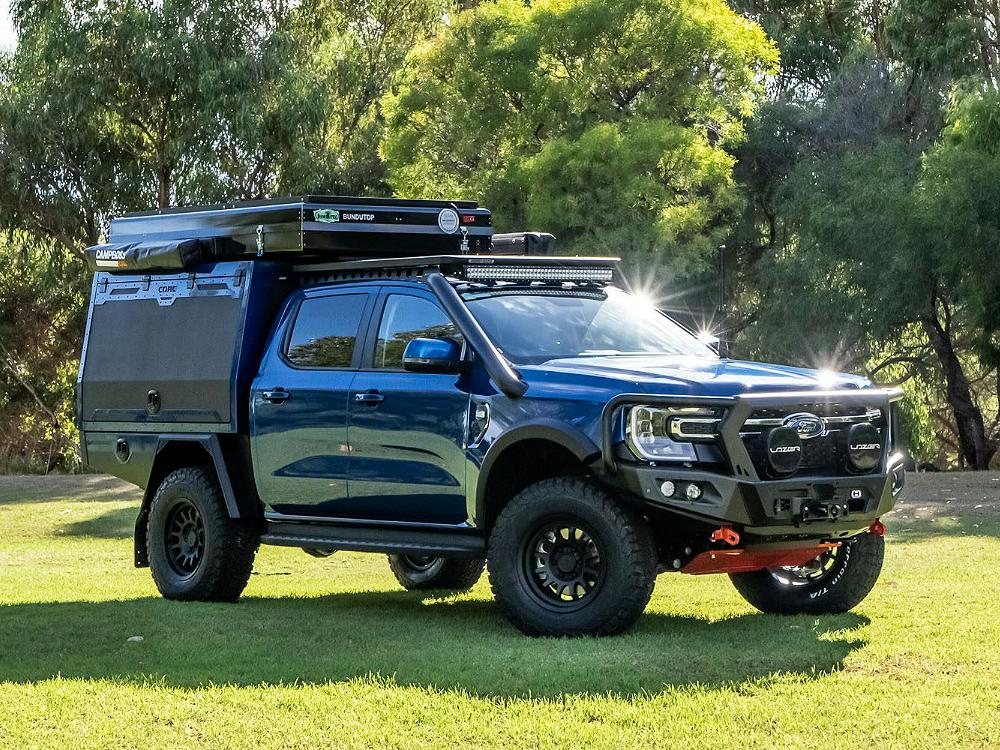
(Full Overlanding Rig: All the systems needed for extended self-reliant travel.)
3. Full Overlanding Rig
Definition: A full overlanding rig is built to be self-sufficient for days, weeks, or months while traveling through remote areas — essentially vehicle + home + supply depot in one package.
Key Features of a Full Overlanding Rig
1. Heavy-Duty Vehicle Build
- Lifted suspension and reinforced shocks
- 33–37″ all-terrain or mud-terrain tires
- Skid plates, rock sliders, and steel bumpers
- Snorkel for deep water crossings
2. Long-Term Shelter & Comfort
- RTT or slide-in camper
- Awning with side walls
- Sleeping for 2–4 people
- Extra insulation for cold weather
3. Self-Sufficiency Systems
- Dual-battery or solar + battery system
- Fridge/freezer (not just a cooler)
- Large water tanks (10–40 gallons) + filtration
- Extra fuel storage (jerry cans or auxiliary tanks)
4. Cooking & Food Storage
- Slide-out kitchen with propane stove
- Counter space for food prep
- Full cookware set and utensils
5. Recovery & Safety Gear
- Winch (8,000–12,000 lb)
- Recovery boards, hi-lift jack, kinetic rope, snatch straps
- On-board air compressor
- Comprehensive first-aid/trauma kits
6. Storage & Organization
- Drawer systems for tools and gear
- MOLLE panels for quick access
- Roof rack for spare tires, kayaks, or extra gear
- Labeled gear boxes for food, clothes, and repair parts
7. Communication & Navigation
- Satellite-based GPS navigation
- HAM or GMRS radio
- Satellite messenger for emergencies
Weight & Size Considerations
- Weight: Often +800–1,500 lbs over stock
- Fuel Economy Impact: Can drop 4–8 mpg
- Height: Roof racks & RTTs can add 12–24″ — watch clearance
Example Ford Ranger Overlanding Build
- 2.5″ lift, heavy-duty leaf springs
- 33″ BFG KO2 all-terrain tires
- Steel bumpers with winch and full skid plates
- Roof rack + RTT + 270° awning
- Rear drawer system with fridge, stove, and gear boxes
- Dual-battery + solar panel on the roof
- 20 gallons extra fuel + 15 gallons water storage
- Complete recovery kit (traction boards, hi-lift, air compressor)
In short: a full overlanding rig is part vehicle, part off-road camper, part survival setup — built for total independence and extended exploration.
Final Thoughts & Next Steps
For the record, I don’t call myself an overlander and I think the term is used to loosely. I use my Ford Ranger for adventures. This county has become obsessed with overlanding and there’s constantly new products and new overlanding events popping up.
Don’t get so consumed in the idea of wanting to be an overlander that you guy out and spend way to much money on things you don’t need.
Your ideal build should match how and how long you want to travel:
- Start lightweight if you’re new or want stealth and mobility.
- Build toward a rugged weekend rig for more capability without committing to heavy modifications.
- Only pursue a full overlanding rig if you truly need long-term independence and have the budget and skills to maintain it.
Also Check Out
How To Build A Ford Ranger For Overlanding
About The Author
Jim Oaks is the founder of TheRangerStation.com, the longest-running Ford Ranger resource online since 1999. With over 25 years of hands-on experience building and modifying Ford Rangers — including magazine-featured builds like Project Transformer — Jim has become one of the most trusted authorities in the Ford Ranger off-road and enthusiast space. In 2019, he was loaned a Ranger FX4 by Ford Motor Company to test and document across the TransAmerica Trail. Jim continues to inspire and guide Ranger owners around the world.

